Nothing says ‘February’ more to me in the garden than snowdrops. Just when we’re really getting fed up with the long dark winter days, along come these elegant white flowers to tell us that spring is just around the corner.

Snowdrop flowerhead (c) John Malone
Unfortunately, when it comes to growing snowdrops, I don’t seem to have much luck. Years ago I bought some bulbs and planted them in what seemed a good place but about one appeared. In fact I think that one is still appearing each spring but it is rather lonely!
At the time I was a relatively inexperienced gardener and, of course, later I read that it is much easier to establish snowdrops ‘in the green’, that is planted out when they have finished flowering but still have their green leaves feeding the bulb beneath. So I acquired some small pots from the garden centre packed full of snowdrops that were just about to finish flowering and I planted them out only never to be seen again. My final foray into attempting to settle them into our garden was a couple of years ago when a friend, who is apparently inundated with them in her garden in Surrey, generously provided me with a large clump which I duly planted in the shade of the hawthorn, yet again with complete and utter failure! I suspect that the problem is that the nice, partially shaded, damp spots beneath trees that I plant them into in the spring, become dry shaded deserts in summer, whereas they actually need to be kept moist to thrive and multiply. It would seem that the naturally forming leaf-mould simply isn’t enough.

Other spring bulbs thrive beneath the hawthorn (c) Elizabeth Malone
I think part of my frustration stems from the fact that we grow other early spring flowers, such as hellebores, really well in similar locations. At the far end of our garden, a few hellebores have magnified into something quite spectacular for a small area. We have cream ones, deep red ones and those that have hybridised to form a mix; and they put on a magnificent display come rain, shine or snow!

Spotted hellebores (c) John Malone
Leucojum, like giant snowdrops, have also done well. The first of these were bought in pots as a ‘past their best’ deal in our local Homebase some years ago. We decided to give them a home and have not regretted it as they have bulked up and flower reliably year after year and look like outlasting the Homebase store!
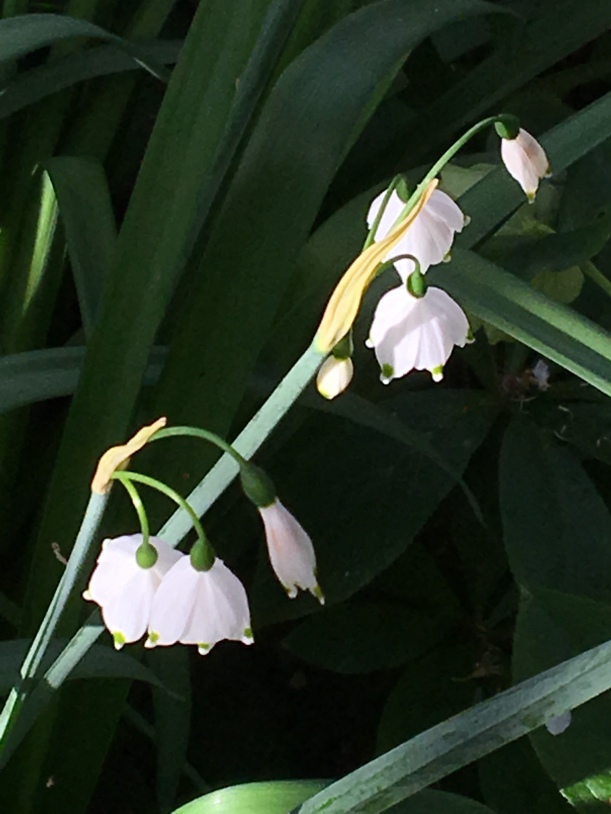
Snowflake flower – Leucojum (c) Elizabeth Malone
So when it comes to snowdrops, I fear that I shall have to make do with admiring other people’s and for me, the first sight of them in 2019 came very early on a visit to RHS Wisley on the 4th January when there were already large clumps fully in flower. Also at Wisley, the curators were busy putting together a very special display in the alpine house of some unusual and valuable examples which have been lent for show just this spring. I couldn’t help but notice the big shiny padlock on the display case and wondered just how much those few plants were worth? Only a few years ago there were newspaper articles of snowdrop bulbs changing hands on the internet for £300!
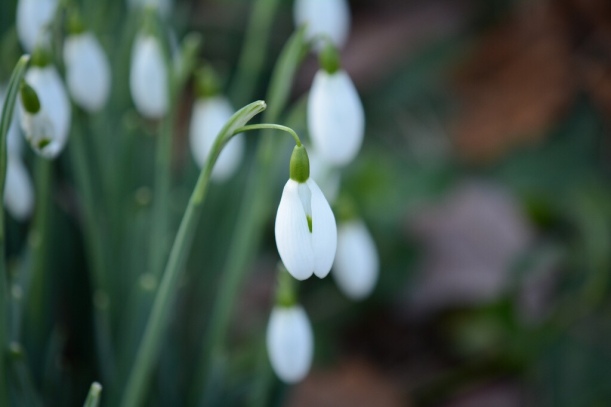
Snowdrops in bud at RHS Wisley (c) John Malone
In February last year we called into Castle Drogo in Devon en route to a weekend in Cornwall. It was a bright spring-like day and as we were tight for time, we enquired where best to see any snowdrops in the grounds. The National Trust volunteer produced a plan of the grounds, studied it carefully, and then started circling a few areas where we might possibly see some. He gave the impression that our chances were slim. So imagine our surprise when we stepped outside the visitor centre only to spot a large clump of nodding white flowers literally yards from the door! And only a few feet further along the path we spotted clump after clump!
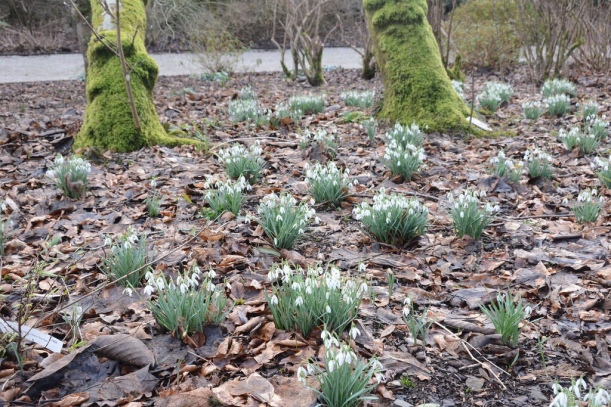
Snowdrops at Castle Drogo, Devon 2018 (c) John Malone
About five years ago, one of our Landmark Trust holidays presented us with plentiful snowdrops right outside the door. We were staying in the wonderfully named House of Correction in Lincolnshire on some very chilly March days (yes, that is snow surrounding the snowdrops you can see in the photo below!) Thankfully most Landmark Trust properties are blessed with a roaring fire and on this occasion we were most grateful for it!
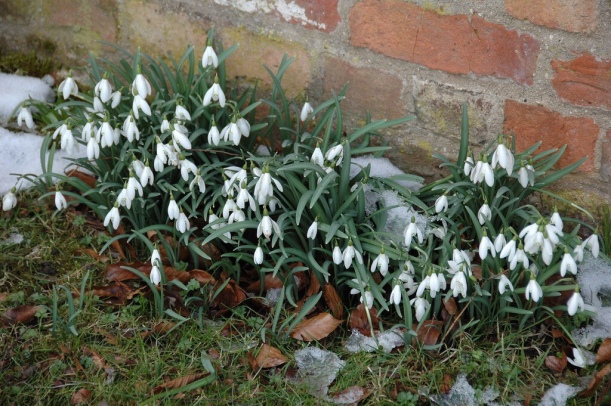
Snowdrops with a little snow at the House of Correction, Lincolnshire (C) John Malone
The potential sight of snowdrops is surely a great incentive to get outdoors at this chilly and gloomy time of year. So where should you head? Well clearly not out into my garden! The National Trust have done a ‘Best places to see snowdrops near you’ list, which is very thoughtful of them. Winkworth Arboretum, which is normally more renowned for its autumn colour or even its bluebells in May, is on the list and is not a million miles from us so we might be taking a trip out!
Meanwhile, do you have a plant that you would love to grow in your garden but which stubbornly refuses to cooperate?


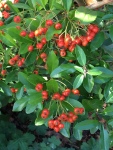











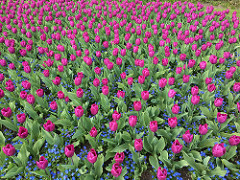

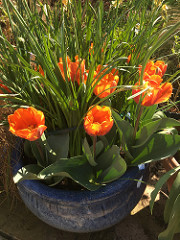 wn, miniature daffodils in the middle, and iris reticulata for the top early layer.
wn, miniature daffodils in the middle, and iris reticulata for the top early layer. rately chose a variety with white / silvery edges which shone through the winter and which I intend to plant out at some point down the far end of the garden where it is incredibly shady and ivy is one of the few things that grows successfully. My thought is that I can at least brighten up this area with the paler leaves. The bulb leaves are now starting to die back and I am wondering whether I can carefully over-plant something for the summer without disturbing the bulbs beneath?
rately chose a variety with white / silvery edges which shone through the winter and which I intend to plant out at some point down the far end of the garden where it is incredibly shady and ivy is one of the few things that grows successfully. My thought is that I can at least brighten up this area with the paler leaves. The bulb leaves are now starting to die back and I am wondering whether I can carefully over-plant something for the summer without disturbing the bulbs beneath? e advice and attempt to naturalise some tulips in the border and, in particular, some rather stunning purple tulips which had flowered at the same time as the bluebells. I could see that they would make a fantastic combination so, instead of leaving them in the pot or lifting them to dry and then be lost at the back of the shed, I decided to transplant them to an area of border directly behind a huge clump of bluebells. To my amazement they have returned this year with some vigour but, guess what? They have flowered at a different time to the bluebells! I guess you can’t win them all!
e advice and attempt to naturalise some tulips in the border and, in particular, some rather stunning purple tulips which had flowered at the same time as the bluebells. I could see that they would make a fantastic combination so, instead of leaving them in the pot or lifting them to dry and then be lost at the back of the shed, I decided to transplant them to an area of border directly behind a huge clump of bluebells. To my amazement they have returned this year with some vigour but, guess what? They have flowered at a different time to the bluebells! I guess you can’t win them all! cheer both sight and smell. Next to the patio, the winter flowering honeysuckle is now covered in sweet scented blooms and its lemony fragrance wafts into the house provided, of course, you are brave enough to open the door and let in the cold wintery air! Various winter flowering clematis are covered in bells, some flushed with burgundy, others creamy white. When the sun has deigned to come out, these have been a magnet for bees. In the border the viburnum is sporting rosy clusters of pink blossom which is complemented by the pinky shades of tiny long-tailed tits who are flitting around the fat balls hanging in the nearby cherry. The viburnum would also smell nice if I donned my gardening boots and fleece and trekked across the muddy grass to give it a sniff. However, the outdoors could not look less enticing right now!
cheer both sight and smell. Next to the patio, the winter flowering honeysuckle is now covered in sweet scented blooms and its lemony fragrance wafts into the house provided, of course, you are brave enough to open the door and let in the cold wintery air! Various winter flowering clematis are covered in bells, some flushed with burgundy, others creamy white. When the sun has deigned to come out, these have been a magnet for bees. In the border the viburnum is sporting rosy clusters of pink blossom which is complemented by the pinky shades of tiny long-tailed tits who are flitting around the fat balls hanging in the nearby cherry. The viburnum would also smell nice if I donned my gardening boots and fleece and trekked across the muddy grass to give it a sniff. However, the outdoors could not look less enticing right now! Plants generally start growing when the temperature reaches about 5o centigrade, which is why I am surprised to see that my bulbs have definitely grown this week. The pot of miniature iris reticulata have suddenly burst into flower! I can also now see just how much the squirrel disturbed them as they are now all on one side of the pot! There are signs of crocus beneath the hawthorn but they are being shy in the gloom. Earlier in the week they were open.
Plants generally start growing when the temperature reaches about 5o centigrade, which is why I am surprised to see that my bulbs have definitely grown this week. The pot of miniature iris reticulata have suddenly burst into flower! I can also now see just how much the squirrel disturbed them as they are now all on one side of the pot! There are signs of crocus beneath the hawthorn but they are being shy in the gloom. Earlier in the week they were open. Elsewhere daffodil leaves are forcing their way upwards. At this point my daffodils always look healthy and robust but, rather annoyingly, when they come to flower, I often discover that the bulbs have been eaten by something and I only get half a ragged trumpet!
Elsewhere daffodil leaves are forcing their way upwards. At this point my daffodils always look healthy and robust but, rather annoyingly, when they come to flower, I often discover that the bulbs have been eaten by something and I only get half a ragged trumpet!
